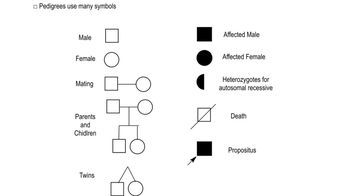Table of contents
- 1. Introduction to Genetics51m
- 2. Mendel's Laws of Inheritance3h 37m
- 3. Extensions to Mendelian Inheritance2h 41m
- 4. Genetic Mapping and Linkage2h 28m
- 5. Genetics of Bacteria and Viruses1h 21m
- 6. Chromosomal Variation1h 48m
- 7. DNA and Chromosome Structure56m
- 8. DNA Replication1h 10m
- 9. Mitosis and Meiosis1h 34m
- 10. Transcription1h 0m
- 11. Translation58m
- 12. Gene Regulation in Prokaryotes1h 19m
- 13. Gene Regulation in Eukaryotes44m
- 14. Genetic Control of Development44m
- 15. Genomes and Genomics1h 50m
- 16. Transposable Elements47m
- 17. Mutation, Repair, and Recombination1h 6m
- 18. Molecular Genetic Tools19m
- 19. Cancer Genetics29m
- 20. Quantitative Genetics1h 26m
- 21. Population Genetics50m
- 22. Evolutionary Genetics29m
2. Mendel's Laws of Inheritance
Pedigrees
Problem 52a
Textbook Question
Textbook QuestionIn humans, the ability to bend the thumb back beyond vertical is called hitchhiker's thumb and is dominant to the inability to do so (OMIM 274200; see Problem 41). Also, the presence of attached earlobes is recessive to unattached earlobes (OMIM 128900).
Using all available and willing members of your family, or members of another family if yours is not easily accessible, trace the transmission of both traits in a pedigree. Use allelic symbols H and h for the thumb and E and e for earlobes, and identify the genotypes for each family member as completely as possible. Bring the pedigree back to share with your group.
 Verified Solution
Verified SolutionThis video solution was recommended by our tutors as helpful for the problem above
Video duration:
4mPlay a video:
251
views
Was this helpful?




